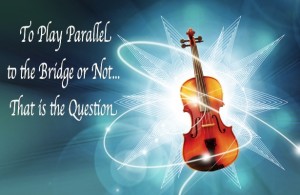Should we be playing with a parallel bow?
We appreciate all of your answers, comments, and ideas in previous articles. The study by Dr. Erwin Schoonderwaldt is one of the only scientific studies on playing parallel to the bridge. However YouTube offers us another opportunity to discover more about this topic by watching real examples. YouTube is a very inspiring new invention that we all use for personal enjoyment, humor, and entertainment. Additionally, it is also a great teaching tool, as we can repeatedly observe what the great players did and/or do. Spending some time every day watching the great players in a very analytical way is one of the best teaching tools available to us.
When watching and listening to these videos try to focus on the way that these great artists control the bow when changing contact points. From my own experience as a teacher I think making rigid rules about any topic can limit us. No two people are the same or have the same body builds, hand size, etc. But, there are still many things that are common to all of us so try to look for that.
First, take a look at this video. What type of movement do you see?
 Now here are some more questions to you for you to answer when watching the videos below:
Now here are some more questions to you for you to answer when watching the videos below:
- Do you think these artists are playing parallel to the bridge most of the time?
- Do you see what they do with the bow when changing the contact point? ( I am quite sure that we will not all perceive what they do the same way?)
- For faster notes are the motions and movement patterns more straight or more curved or elliptical?
- Do you see any common denominators between how these artists use and move there bows?
- Please recommend some videos to String Visions with great players where the camera is focused for a long time on the bow and where it is easy to observe what is happening. When doing this please also give us your personal insights?
Please answer some of these questions. After watching the videos let’s address the issue again of whether or not we should be playing with a parallel bow. Have your ideas changed after watching particular performers and hearing the sound they produce? Additionally, we would love to see you post some of your own related comments and questions.
It can be hard finding videos where the camera is focused on the bow for a long time so I’ve noted where in each video to look.
Video #1: Pinchas Zukerman plays sonata number 3 op. 108 by Brahms
In this video first watch the opening of the Brahms sonata and observe what a beautiful cresc. Mr. Zukermann creates by starting at the tip very close to the fingerboard and by slanting the frog very much towards the bridge. At the moment that the top of the cresc (in the middle of the bow) is achieved the bow angle gets more parallel to the bridge.
Video #2: Heifetz plays La Fille Aux Cheveax De Lin.
In the Heifetz video in addition to answering the above questions also observe how Mr. Heifetz actually very often follows one of the rules that his teacher the great Leopold Auer advocated. Namely at the tip for a smooth bow from down bow to up bow tilt and turn the bow around its longitudinal axis towards full hair. [2]
Video #3: Pierre Fournier, violoncello. Robert Schumann cello concerto, 1850
A very beautiful performance by Pierre Fournier. Go to the second movement and the video is focused on the bow for half the time.
Here are two videos with wonderful cello playing and great views of the bow arm
Video #4: Steven Isserlis & Denes Varjon in a most refined, delicate and sensitive performance of Schumann: Abenlied op.85, no 2.
Video #5: Arto Noras in a very beautiful charming performance of the Haydn C major Concerto. His legato playing is just so terrific that it makes me smile.
[1] On the use of Skewness in Violin Bowing: Should the bow be straight or not? Acta Acustica United with Acustica Vol. 96 (2010) 593-602
[2] In down bow only the edge of the hair contact the string at the nut—with the stick inclined towards the fingerboard. During the course of the down-stroke,the bow is gradually turned around its longitudinal axis until the full width of the hair comes in contact with the string. (when approaching the tip). In up-bow, the rotation of the bow proceeds in reversed sequence. (Go from flatter hair back towards the edge of the hair) Leopold Auer. Senso-Motor study and its application to violin playing. Dr. Frederick F. Polnauer and Dr. Morton Marks. American String Teachers Association, Urbana, Illinois 1964. Graded Course in violin playing. Leopold Auer, New York, C. Fisher 1926.















On cello, for cantabile playing in mf and louder, I find it helpful to angle the tip slightly to the floor. This has the effect (in downbow) of drawing the contact point toward the bridge, or at least keeping it from tending toward the fingerboard. This helps keep an ‘in the string” or “spun” as Rose called it (or so I’m told) sound even as the ability to maintain pressure (or “weight”) deminishes as the bow moves toward the upper half and to the point. This is not as critical in the up-bow, so I don’t think it necessary to angle the bow in the opposite manner (point up) because mainatining a good contact is much easier; sometimes too easy leading to unwarted crescendos.
The matter of the angle of the hair vis-a-vis the longitudinal axis is subtler, I think, and has more to do with nuance “within” the sound rather than brute sund production, so to speak. It seems to me that the angling of the hair edge on to the string allows finer gradations of pressure (ok, “weight” to be brought to transmitted to the contact “point” than is possible with flat hair. This is due to the force of the arm/hand being partially taken up by the bending of the stick in the “wrong” vector.
Hans, Thank you for posting this discussion! It is wonderful to see this topic discussed—I spend SO much time teaching my students about this… thank you for reinforcing the idea very clearly—love the youtube examples!
Music, like philosophy, has no right answers. Parallel bowing makes it possible keep the contact point steady, thus maintaining the balance of overtones (as the bow moves closer to the bridge, the higher overtones are magnified and vice versa). Great players are capable of changing their contact points according to the sound they desire to create. In order to be fluent in the creation of sound, it is necessary to be able to control the contact point. Pulling the bow parallel to the string is part of this control. But the contact point, which determines tone and bow speed, is always subordinate to the artist’s conception of the music they are trying to create.
That’s my take, anyhow.
This is a terrific video where Todd Ehle explains the figure eight bowing:
http://www.youtube.com/watch?v=WVJGYgRGKI8
Hans, thanks for including me here. I don’t try to play parallel to the bridge, I just aim for a specific sound, which causes the bow to find the proper place, at least most of the time. With students, I do teach them to steer the bow in line with the bridge, as anything else is too vague. The concept of bowing parallel to the bridge seems simple enough, but in reality it needs to be accomplished by ‘feel,’ (for a violinist, it’s very difficult to actually see due to the optical illusion created by the curved bridge, plus the proximity and angle of vision). A mirror can help, but the most effecting technique I’ve found is staring right at the contact point (bow/string), watching for any sliding toward or away from the bridge. The more advanced bowing will come as their inner voice, and technical abilities develop.
me to, i just want to hear my sound perfectly in tune. and in good pitch.thanks mr.todd and to you mr.hans by the way im from philippines. violin is a rare instrument here.
for violin & viola, flat hair at the upper half and tip give a fuller tone. In general, faster bow-work will be straighter, while longer strokes will elipse, as in the Heifetz video, per the Auer outline.